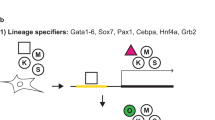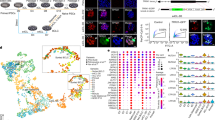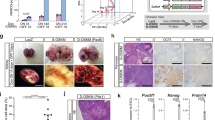Abstract
Induced pluripotent stem cells (iPSCs) are generated from somatic cells by the transgenic expression of three transcription factors collectively called OSK: Oct3/4 (also called Pou5f1), Sox2 and Klf41. However, the conversion to iPSCs is inefficient. The proto-oncogene Myc enhances the efficiency of iPSC generation by OSK but it also increases the tumorigenicity of the resulting iPSCs2. Here we show that the Gli-like transcription factor Glis1 (Glis family zinc finger 1) markedly enhances the generation of iPSCs from both mouse and human fibroblasts when it is expressed together with OSK. Mouse iPSCs generated using this combination of transcription factors can form germline-competent chimaeras. Glis1 is enriched in unfertilized oocytes and in embryos at the one-cell stage. DNA microarray analyses show that Glis1 promotes multiple pro-reprogramming pathways, including Myc, Nanog, Lin28, Wnt, Essrb and the mesenchymal–epithelial transition. These results therefore show that Glis1 effectively promotes the direct reprogramming of somatic cells during iPSC generation.
This is a preview of subscription content, access via your institution
Access options
Subscribe to this journal
Receive 51 print issues and online access
$199.00 per year
only $3.90 per issue
Buy this article
- Purchase on Springer Link
- Instant access to full article PDF
Prices may be subject to local taxes which are calculated during checkout




Similar content being viewed by others
Accession codes
Primary accessions
Gene Expression Omnibus
Data deposits
The microarray data are available from the Gene Expression Omnibus (GEO, http://www.ncbi.nlm.nih.gov/geo/) with the accession number GSE26431.
References
Takahashi, K. & Yamanaka, S. Induction of pluripotent stem cells from mouse embryonic and adult fibroblast cultures by defined factors. Cell 126, 663–676 (2006)
Nakagawa, M. et al. Generation of induced pluripotent stem cells without Myc from mouse and human fibroblasts. Nature Biotechnol. 26, 101–106 (2008)
Yamanaka, S. A fresh look at iPS cells. Cell 137, 13–17 (2009)
Yamanaka, S. Strategies and new developments in the generation of patient-specific pluripotent stem cells. Cell Stem Cell 1, 39–49 (2007)
Yamanaka, S. Elite and stochastic models for induced pluripotent stem cell generation. Nature 460, 49–52 (2009)
Yamanaka, S. & Blau, H. M. Nuclear reprogramming to a pluripotent state by three approaches. Nature 465, 704–712 (2010)
Wilmut, I., Schnieke, A. E., McWhir, J., Kind, A. J. & Campbell, K. H. Viable offspring derived from fetal and adult mammalian cells. Nature 385, 810–813 (1997)
Egli, D., Rosains, J., Birkhoff, G. & Eggan, K. Developmental reprogramming after chromosome transfer into mitotic mouse zygotes. Nature 447, 679–685 (2007)
Okita, K., Ichisaka, T. & Yamanaka, S. Generation of germ-line competent induced pluripotent stem cells. Nature 448, 313–317 (2007)
Kim, Y. S. et al. Identification of Glis1, a novel Gli-related, Kruppel-like zinc finger protein containing transactivation and repressor functions. J. Biol. Chem. 277, 30901–30913 (2002)
Guo, G. et al. Resolution of cell fate decisions revealed by single-cell gene expression analysis from zygote to blastocyst. Dev. Cell 18, 675–685 (2010)
Hong, H. et al. Suppression of induced pluripotent stem cell generation by the p53-p21 pathway. Nature 460, 1132–1135 (2009)
Feng, B. et al. Reprogramming of fibroblasts into induced pluripotent stem cells with orphan nuclear receptor Esrrb. Nature Cell Biol. 11, 197–203 (2009)
Marson, A. et al. Wnt signaling promotes reprogramming of somatic cells to pluripotency. Cell Stem Cell 3, 132–135 (2008)
Yu, J. et al. Induced pluripotent stem cell lines derived from human somatic cells. Science 318, 1917–1920 (2007)
Silva, J. et al. Nanog is the gateway to the pluripotent ground state. Cell 138, 722–737 (2009)
Nakagawa, M., Takizawa, N., Narita, M., Ichisaka, T. & Yamanaka, S. Promotion of direct reprogramming by transformation-deficient Myc. Proc. Natl Acad. Sci. USA 107, 14152–14157 (2010)
Samavarchi-Tehrani, P. et al. Functional genomics reveals a BMP-driven mesenchymal-to-epithelial transition in the initiation of somatic cell reprogramming. Cell Stem Cell 7, 64–77 (2010)
Li, R. et al. A mesenchymal-to-epithelial transition initiates and is required for the nuclear reprogramming of mouse fibroblasts. Cell Stem Cell 7, 51–63 (2010)
Niwa, H., Burdon, T., Chambers, I. & Smith, A. Self-renewal of pluripotent embryonic stem cells is mediated via activation of STAT3. Genes Dev. 12, 2048–2060 (1998)
Goshima, N. et al. Human protein factory for converting the transcriptome into an in vitro-expressed proteome. Nature Methods 5, 1011–1017 (2008)
Takahashi, K. et al. Induction of pluripotent stem cells from adult human fibroblasts by defined factors. Cell 131, 861–872 (2007)
Morita, S., Kojima, T. & Kitamura, T. Plat-E: an efficient and stable system for transient packaging of retroviruses. Gene Ther. 7, 1063–1066 (2000)
McMahon, A. P. & Bradley, A. The Wnt-1 (int-1) proto-oncogene is required for development of a large region of the mouse brain. Cell 62, 1073–1085 (1990)
Hashimoto, J. et al. Novel in vitro protein fragment complementation assay applicable to high-throughput screening in a 1536-well format. J. Biomol. Screen. 14, 970–979 (2009)
Acknowledgements
We thank T. Yamamoto, Y. Yamada and the members of our laboratory for valuable scientific discussions and administrative support. We thank M. Nakagawa, H. Seki, M. Murakami, A. Okada, M. Narita, M. Inoue, H. Shiga and T. Matsumoto for technical assistance and H. Suemori (Kyoto University) for human ES cells. This work was supported in part by grants from the New Energy and Industrial Technology Development Organization (NEDO), the Leading Project of the Ministry of Education, Culture, Sports, Science and Technology (MEXT), the Funding Program for World-Leading Innovative R&D on Science and Technology (FIRST Program) of the Japanese Society for the Promotion of Science (JSPS), Grants-in-Aid for Scientific Research from JSPS and MEXT, and the Program for Promotion of Fundamental Studies in Health Sciences of the National Institute of Biomedical Innovation (NIBIO). S.Y. is a member of scientific advisory boards of iPearian Inc. and iPS Academia Japan.
Author information
Authors and Affiliations
Contributions
M.M. conducted most of the experiments in this study. K.Y. analysed the interactions of proteins. T.N. performed the computer analyses of the DNA microarray data, teratoma experiments, overexpression in ES cells and statistical analysis. R.S. generated mouse iPSCs and characterized mouse and human iPSCs. I.K. generated human iPSCs. T.I. performed the chimaera and teratoma experiments and maintained the mouse lines. Y.K. selected cDNA clones from HuPEX with bioinformatics. H.M. produced the retroviral expression clones. N.G. and S.Y. supervised the project. M.M. and S.Y. wrote the manuscript.
Corresponding authors
Ethics declarations
Competing interests
The authors declare no competing financial interests.
Supplementary information
Supplementary Information
This file contains Supplementary Figures 1-10 with legends and Supplementary Tables 1-6. (PDF 2558 kb)
Rights and permissions
About this article
Cite this article
Maekawa, M., Yamaguchi, K., Nakamura, T. et al. Direct reprogramming of somatic cells is promoted by maternal transcription factor Glis1. Nature 474, 225–229 (2011). https://doi.org/10.1038/nature10106
Received:
Accepted:
Published:
Issue Date:
DOI: https://doi.org/10.1038/nature10106
This article is cited by
-
Establishment of African pygmy mouse induced pluripotent stem cells using defined doxycycline inducible transcription factors
Scientific Reports (2024)
-
Challenges with Cell-based Therapies for Type 1 Diabetes Mellitus
Stem Cell Reviews and Reports (2023)
-
Identification of Optimal Expression Parameters and Purification of a Codon-Optimized Human GLIS1 Transcription Factor from Escherichia coli
Molecular Biotechnology (2022)
-
Molecular dynamics of estrogen-related receptors and their regulatory proteins: roles in transcriptional control for endocrine and metabolic signaling
Anatomical Science International (2022)
-
Organoids in domestic animals: with which stem cells?
Veterinary Research (2021)
Comments
By submitting a comment you agree to abide by our Terms and Community Guidelines. If you find something abusive or that does not comply with our terms or guidelines please flag it as inappropriate.



